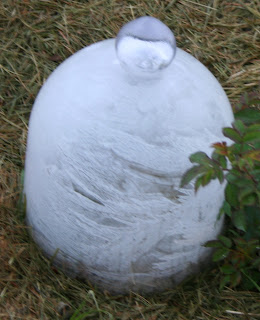 |
| Rosa 'Golden Princess' |
'Golden Princess' seems to be a little-known output from Dr. Buck, but I believe she deserves better recognition. The earliest official description I have from an often copied, old type-written font sheet, is that she is a yellow-blend shrub rose of 1984 vintage. The current Iowa State extension website describes the rose and its coloring in dry terms as "The large, ovoid-pointed buds of pale aureolin yellow (RHSCC 12D) open to double (30-35 petals), cupped, open. 4-4.5 inch blooms of deeper aureolin yellow (RHSCC 12A) tinted spinel red (RHSCC 54A) on petal edges, and finishing pale spinel red (RHSCC 54C)." I suppose that if you have a Royal Horticultural Society Colour Chart, you could make probably some sense of that cold scientific description, but suffice it to say that the picture at upper right is accurately hued, and the rose is essentially a yellow-cream-golden blend fading to pink and almost red at the edges. For those who like golden-yellow-peachish-orange blooms such as Peace and Alchymist, this rose is a "must grow."
'Golden Princess' blooms all summer in clusters of 1-5 and the blooms have a moderate degree of fragrance. The rose survives here in Zone 5B Kansas with some tip die-back noted both years that I have grown it, but the semi-glossy, dark green foliage is iron clad during the growing season and requires no spray for disease. Parentage was a little hard to come by, but is listed on the Elko County, Nevada, Rose website and on helpmefind as "Hawkeye Belle (seed) X (Roundelay X Country Music) (pollen). I don't know how those writers know that, so take that information with a grain of salt. Regardless, as a shrub, 'Golden Princess' is small, only about 2 feet tall and 1.5 feet wide beginning its third summer for me, so it is perfectly suited for a small garden. As the only drawback that I can see, it has large tan thorns that are a bit on the wicked side when it comes time for Spring pruning.
Give her a try for a manageable shrub rose of startling beauty. Did I mention that the best part of this rose may be the just-opening buds?



